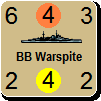warspite1
Posts: 41353
Joined: 2/2/2008
From: England
Status: offline

|
Next in the series - an Italian Battleship
[4978 Conte Di Cavour - By Robert Jenkins]
.B Engine(s) output: 93,000 hp
.B Top Speed: 28 knots
.B Main armament: 10 x 12.6-inch (320mm), 12 x 4.7-inch (120mm) guns.
.B Displacement (full load): 29,032 tons
.B Thickest armour: 10-inch (belt)
.P The three ships of the Cavour-class were built for the Regia Marina (RM)
between July 1910 and May 1914. They were the first Italian dreadnoughts.
.P They were originally fitted with a 12-inch main armament and were much less
powerful and slower ships than at the outbreak of the Second World War. However,
in the thirties the two surviving ships of the class were completely re-built.
Note the technical data above is after the modernisation program, completed in
1937. The third ship, Leonardo Da Vinci, was the victim of an internal explosion
during the First World War and she was not repaired.
.P The class also received completely new machinery which added 6 knots to their
original speed and the armoured protection was much enhanced and improved and
included a new underwater protection system.
.P Conte Di Cavour, named after a famous statesman who was heavily involved in
Italian unification during the 19th century, was completed in April 1915. At the
outbreak of the Second World War she was part of the 5th Battleship Division.
.P On the 9th July 1940, she took part in the inconclusive Battle of Punta Stilo
(Calabria), the first naval battle between the British and Italian fleets (see
Giulio Cesare).
.P The previous engagement at Punta Stilo made it clear to the Royal Navy that
they needed reinforcements in the Mediterranean. The first major operation to get
additional ships to the Mediterranean Fleet was launched at the end of August.
The British Operation HATS arguably gave the RM their best chance of the entire
war to inflict serious damage on the Royal Navy; it was a chance they squandered.
.P HATS attempted to get the new fleet carrier Illustrious, the battleship
Valiant, two anti-aircraft cruisers and additional destroyers to Alexandria. They
were escorted in the Western Mediterranean by the trouble-shooting Force H; but
this force was not to be the target of the Italian Fleet. Instead, it was the
Mediterranean Fleet, sailing from Alexandria to escort a Malta bound convoy and
to escort the reinforcements once they had left Force H, that were the targets.
The Mediterranean Fleet consisted of the old carrier Eagle, the battleships
Warspite and Malaya, the heavy cruiser Kent, the light cruisers Orion, Sydney,
Gloucester and Liverpool and escorting destroyers.
.P The Italians, commanded by Admiral Iachino, countered with no less than five
battleships and importantly, two of these were from the new Littorio-class. These
were Littorio, Vittorio Veneto, Caio Duillo, Conti Di Cavour and Giuilo Cesare.
In support were four heavy cruisers of the 1st Division, Pola, Zara, Fiume and
Gorizia, the light cruisers Abruzzi and Garibaldi of the 8th Division and a large
destroyer escort.
.P The Italian operation was hampered by problems with Cesare that meant she was
initially left behind in port. However, even with this set-back, the superiority
enjoyed by the Italians meant that the Royal Navy could find themselves in
trouble if the two fleets met. Although the British had the carrier Eagle, the
elderly carrier had less than twenty aircraft available. The rest of the fleet
sailed from Taranto and took up position to the south of Taranto and north-east
of Malta to await the British. But the Italian high command, incredibly, recalled
the fleet in the late afternoon.
.P They later reversed the decision and the fleet sailed south once more; this
time with the benefit of the repaired Cesare, in the hope that they would catch
the Royal Navy as they returned from Malta. However, the Italians paid for their
earlier indecision. The weather conditions had deteriorated and they were unable
to locate the enemy in the heavy seas. Furthermore, the Italian destroyers
struggled to maintain position in these conditions and many reached port in a
damaged condition. It was a disaster for the RM.
.P The beginning of the end for Conti Di Cavour came with the audacious British
attack on the Italian Fleet at Taranto in November 1940 (see Littorio). During
the attack by a handful of bi-plane Swordfish torpedo bombers launched from the
carrier Illustrious, she was hit by a torpedo and sank to the bottom of the
shallow harbour. Although she was eventually raised and sent to the port of
Trieste, she was never sufficiently repaired to see active service at sea again.
.P In September 1943, the Italians signed the Armistice with the Allies. Conti Di
Cavour was at Trieste and was scuttled by her crew. The Germans later raised her,
but she never went to sea again. Her end came on the 17th February 1945. She was
still at Trieste when she was bombed by British aircraft, causing her to sink for
the third time in the war; this time for good.
< Message edited by warspite1 -- 8/9/2009 4:17:26 PM >
_____________________________
England expects that every man will do his duty. Horatio Nelson October 1805  |
 Printable Version
Printable Version







 . Therefore, if I think a spelling in the Master File is incorrect I will simply amend that and advise you / Patrice.
. Therefore, if I think a spelling in the Master File is incorrect I will simply amend that and advise you / Patrice.





 .
. 



 New Messages
New Messages No New Messages
No New Messages Hot Topic w/ New Messages
Hot Topic w/ New Messages Hot Topic w/o New Messages
Hot Topic w/o New Messages Locked w/ New Messages
Locked w/ New Messages Locked w/o New Messages
Locked w/o New Messages Post New Thread
Post New Thread